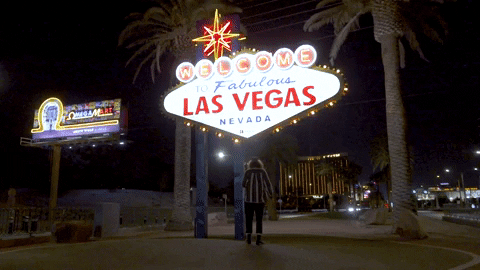Man uses 'Death of Las Vegas' trend to explain why Americans are done being exploited
What's happening to Las Vegas is a metaphor for how people are feeling about the economy.
The Las Vegas strip.
The "Vegas is Dead" trend on social media has TikTokers sharing videos of an empty Strip and casinos, speculating about where all the tourists have gone. The online speculation is supported by numerous reports indicating that tourism to Sin City is down in 2025. A June report found that overall visitor numbers are down six percent for the first half of the year, with international visitor arrivals falling by over 13 percent in June compared to the same period in the previous year.
There has also been a sharp decline in Canadian visitors due to the White House’s push to make the country America’s 51st state. However, there’s also considerable speculation that Vegas has become too expensive for the average American, and even if they can afford the inflated prices, the price hikes make it a less enjoyable experience. Vegas was once a place where people went to get free drinks in casinos, cheap rooms during the week, and inexpensive buffets to entice them to gamble the rest of their money. These days, critics say the casinos want to price gouge and get you to gamble as well.
How expensive is Las Vegas?
Hotels have been removing coffee makers, forcing visitors to buy eight dollar coffees in the casino. A visitor recently shared that she had been charged $26 for a bottle of Fiji water from the minibar in her room at the Aria Resort & Casino. A British magician was charged $74.41 for two drinks at the Sphere, and some hotels charge $50 just to use the mini-fridge.
"On the Strip, people get taken for a ride. Once they get here, they're like, 'I'm tired of being treated like this. I'm tired of having to pay these ridiculous prices,’” Anthony Curtis, publisher of the Las Vegas Advisor website, told The Independent. "There are fees all over the place—fees to park, resort fees on top of room rates. And people are getting fed up with it. We hear that a lot from our customers."
“Vegas is not fun anymore,” Amrita Bhasin, a retail-industry entrepreneur, told MarketWatch.
Why are people turned off by Las Vegas?
TikToker Nathan Ramos-Park recently shared his thoughts on why Vegas is struggling, and he views it as part of a broader trend across America. Ramos-Park is a film and TV writer behind Five Blind Dates, Ero, and Picture This. He says that the city’s prices are so high that they feel exploitative to most people, so Vegas no longer provides the “escapism” it once did.
@nathanramospark Las Vegas no longer lets people feel escapism. It exploits so hard that people can’t afford to feel any joy which makes them in turn abandon their vices. It’s too expensive to gamble or eat or even park. There’s no coffee makers in the rooms there’s no microwave. There’s no way for people to experience joy modestly. In a way it mocks people. This will be the continuing downfall of Vegas and is a reflection of a broken system where people are exploited too hard. #lasvegas #edc #rio #caesarspalace #bellagio #fountain #fattuesday #thestrip #downtown #losangeles #escapism #exploitation #capitalism #microwave #dinner #coffee #downfall
Ramos-Park recalls going to Vegas in his 20s and getting a 5-star hotel for $20, free bottle service, and, for $100 between three people, they were able to have a “catharsis where we can eat as much as we want, drink as much as we want and it just doesn't exist anymore in Vegas.”
“Everything is just so prohibitively expensive, like buffets are over 80 bucks, even just a park on the strip was $20 for an hour,” he said before arguing that it just feels like “exploitation." Ramos-Park says it’s unnecessary because during uncertain economic times, people want to “escape” and if Vegas lowered its prices, “people would come and fall into the same traps of gambling and losing their money, but they would be happy to do so.”
@bshel74 What is going on here in Vegas? Never seen it so slow. Every casino and restaurant are pretty empty. #Vegas
He adds that his price-gouging leads people to resent corporatism, and it’s not just happening in Vegas, but also in big cities such as Los Angeles, Chicago, San Francisco, New York, and Seattle.
“It ends up hurting everybody. Ends up hurting the business. Ends up hurting the people. That ends up hurting the community, and so I think we're gonna see a lot of counter programming start to pop up, in the next three to five years, against these big kind of corporate locations," he said.
"This is also why I don’t get how there are any Disney adults left. How can you experience escapism when you’re being charged $25 for a lollipop," one commenter wrote. "I noticed the coffee machines being removed from rooms several years ago and it was then I knew we were never going back to the good days," another added.
Whether it’s a surprise resort fee in Vegas, $17 beers at a baseball game, a $45 service charge for Taylor Swift tickets, or a $100 fee to check a bag, people are fed up with being nickel-and-dimed by corporations, and sooner or later, there’s going to be pushback. Hopefully, this downward trend in visitors to Vegas is the wake-up call the town needs to make things reasonably priced again so people will return. Remember, casinos, you can always get ‘em back at the roulette wheel, but you don’t stand a chance if they aren't willing to show up in the first place.

